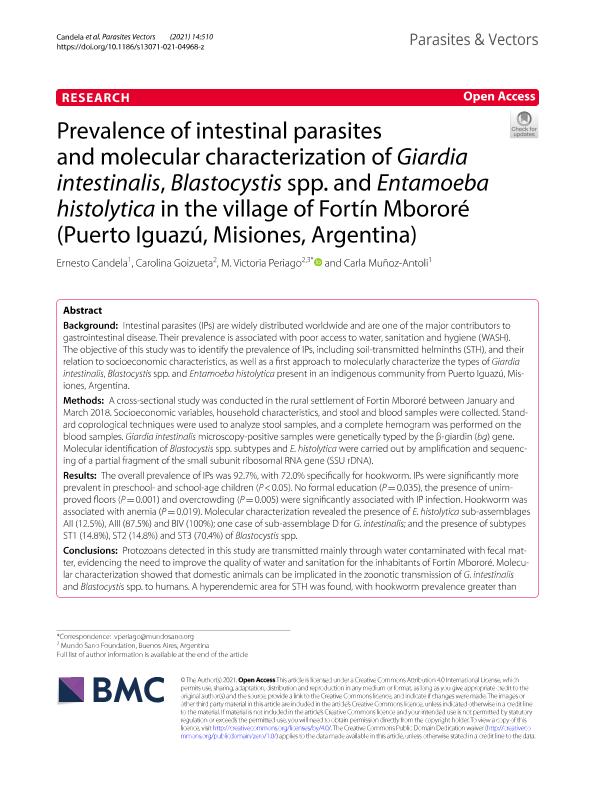Mostrar el registro sencillo del ítem
dc.contributor.author
Candela, Ernesto
dc.contributor.author
Goizueta, Carolina
dc.contributor.author
Periago, Maria Victoria

dc.contributor.author
Muñoz Antoli, Carla
dc.date.available
2022-08-29T16:46:23Z
dc.date.issued
2021-10
dc.identifier.citation
Candela, Ernesto; Goizueta, Carolina; Periago, Maria Victoria; Muñoz Antoli, Carla; Prevalence of intestinal parasites and molecular characterization of Giardia intestinalis, Blastocystis spp. and Entamoeba histolytica in the village of Fortín Mbororé (Puerto Iguazú, Misiones, Argentina); BioMed Central; Parasites and Vectors; 14; 510 ; 10-2021; 1-15
dc.identifier.issn
1756-3305
dc.identifier.uri
http://hdl.handle.net/11336/166851
dc.description.abstract
Background: Intestinal parasites (IPs) are widely distributed worldwide and are one of the major contributors to gastrointestinal disease. Their prevalence is associated with poor access to water, sanitation and hygiene (WASH). The objective of this study was to identify the prevalence of IPs, including soil-transmitted helminths (STH), and their relation to socioeconomic characteristics, as well as a first approach to molecularly characterize the types of Giardia intestinalis, Blastocystis spp. and Entamoeba histolytica present in an indigenous community from Puerto Iguazú, Misiones,Argentina. Methods: A cross-sectional study was conducted in the rural settlement of Fortin Mbororé between January and March 2018. Socioeconomic variables, household characteristics, and stool and blood samples were collected. Standard coprological techniques were used to analyze stool samples, and a complete hemogram was performed on the blood samples. Giardia intestinalis microscopy-positive samples were genetically typed by the β-giardin (bg) gene. Molecular identification of Blastocystis spp. subtypes and E. histolytica were carried out by amplification and sequencing of a partial fragment of the small subunit ribosomal RNA gene (SSU rDNA). Results: The overall prevalence of IPs was 92.7%, with 72.0% specifically for hookworm. IPs were significantly more prevalent in preschool- and school-age children (P < 0.05). No formal education (P = 0.035), the presence of unimproved floors (P = 0.001) and overcrowding (P = 0.005) were significantly associated with IP infection. Hookworm was associated with anemia (P = 0.019). Molecular characterization revealed the presence of E. histolytica sub-assemblages AII (12.5%), AIII (87.5%) and BIV (100%); one case of sub-assemblage D for G. intestinalis; and the presence of subtypes ST1 (14.8%), ST2 (14.8%) and ST3 (70.4%) of Blastocystis spp. Conclusions: Protozoans detected in this study are transmitted mainly through water contaminated with fecal matter,evidencing the need to improve the quality of water and sanitation for the inhabitants of Fortín Mbororé. Molecular characterization showed that domestic animals can be implicated in the zoonotic transmission of G. intestinalis and Blastocystis spp. to humans. A hyperendemic area for STH was found, with hookworm prevalence greater than 50%. Therefore, improvements in WASH as well as mass deworming programs need to be implemented in this area to control and decrease the prevalence of IPs in general and STH in particular.
dc.format
application/pdf
dc.language.iso
eng
dc.publisher
BioMed Central

dc.rights
info:eu-repo/semantics/openAccess
dc.rights.uri
https://creativecommons.org/licenses/by/2.5/ar/
dc.subject
ARGENTINA
dc.subject
BLASTOCYSTIS SPP
dc.subject
ENTAMOEBA HISTOLYTICA
dc.subject
GIARDIA INTESTINALIS
dc.subject
INTESTINAL PARASITES
dc.subject
MISIONES
dc.subject
MOLECULAR CHARACTERIZATION
dc.subject
PUERTO IGUAZÚ
dc.subject
SOIL-TRANSMITTED HELMINTHS
dc.subject.classification
Otros Tópicos Biológicos

dc.subject.classification
Ciencias Biológicas

dc.subject.classification
CIENCIAS NATURALES Y EXACTAS

dc.title
Prevalence of intestinal parasites and molecular characterization of Giardia intestinalis, Blastocystis spp. and Entamoeba histolytica in the village of Fortín Mbororé (Puerto Iguazú, Misiones, Argentina)
dc.type
info:eu-repo/semantics/article
dc.type
info:ar-repo/semantics/artículo
dc.type
info:eu-repo/semantics/publishedVersion
dc.date.updated
2022-08-19T15:21:51Z
dc.journal.volume
14
dc.journal.number
510
dc.journal.pagination
1-15
dc.journal.pais
Reino Unido

dc.journal.ciudad
Londres
dc.description.fil
Fil: Candela, Ernesto. Universidad de Valencia; España
dc.description.fil
Fil: Goizueta, Carolina. Fundación Mundo Sano; Argentina
dc.description.fil
Fil: Periago, Maria Victoria. Consejo Nacional de Investigaciones Científicas y Técnicas; Argentina. Fundación Mundo Sano; Argentina
dc.description.fil
Fil: Muñoz Antoli, Carla. Universidad de Valencia; España
dc.journal.title
Parasites and Vectors

dc.relation.alternativeid
info:eu-repo/semantics/altIdentifier/url/https://parasitesandvectors.biomedcentral.com/articles/10.1186/s13071-021-04968-z
dc.relation.alternativeid
info:eu-repo/semantics/altIdentifier/doi/http://dx.doi.org/10.1186/s13071-021-04968-z
Archivos asociados
